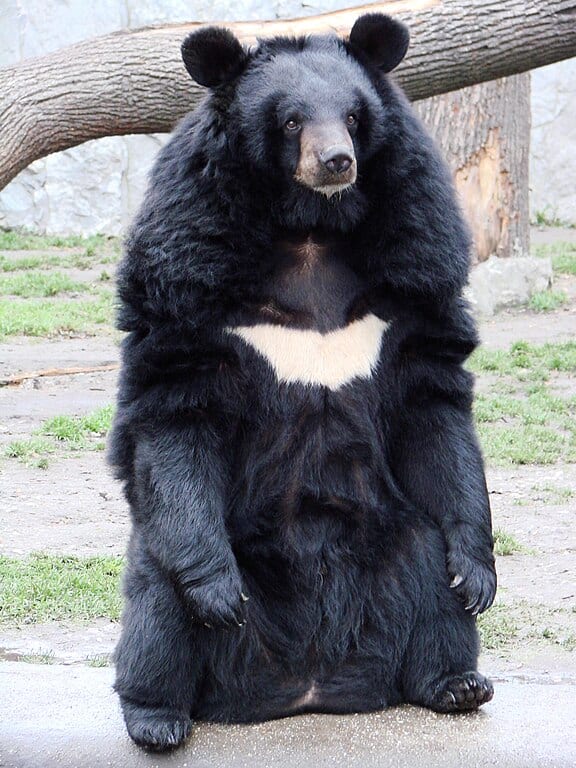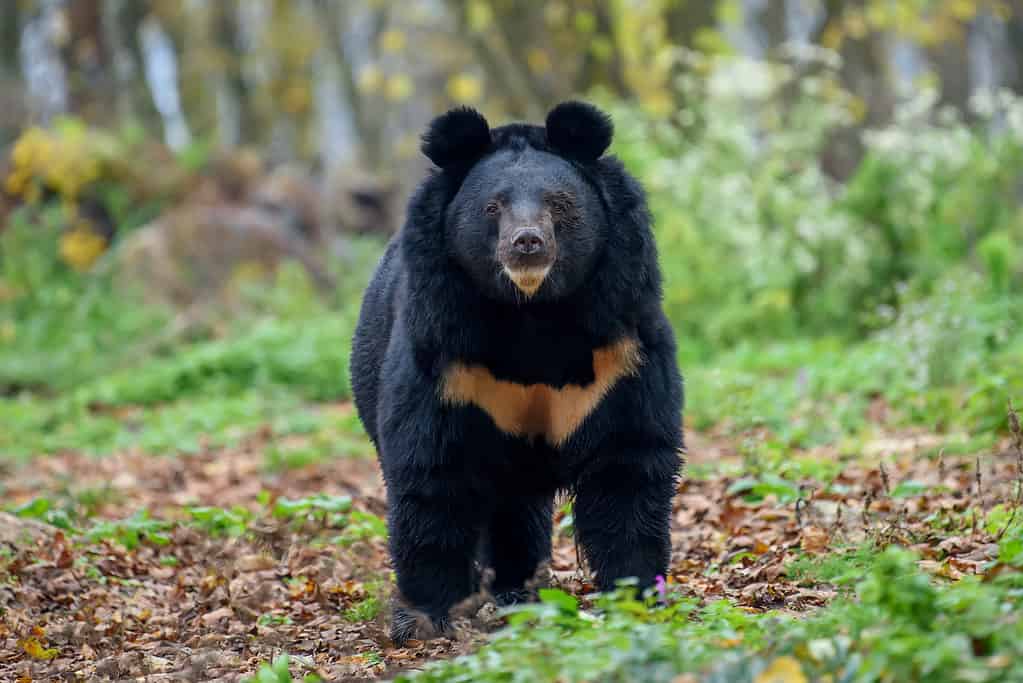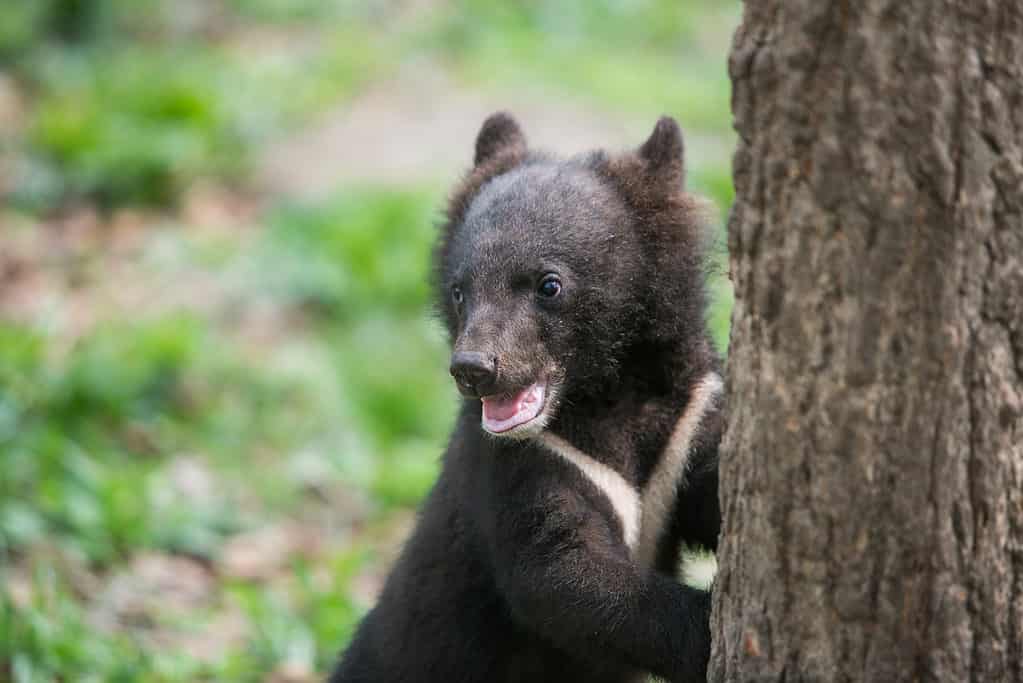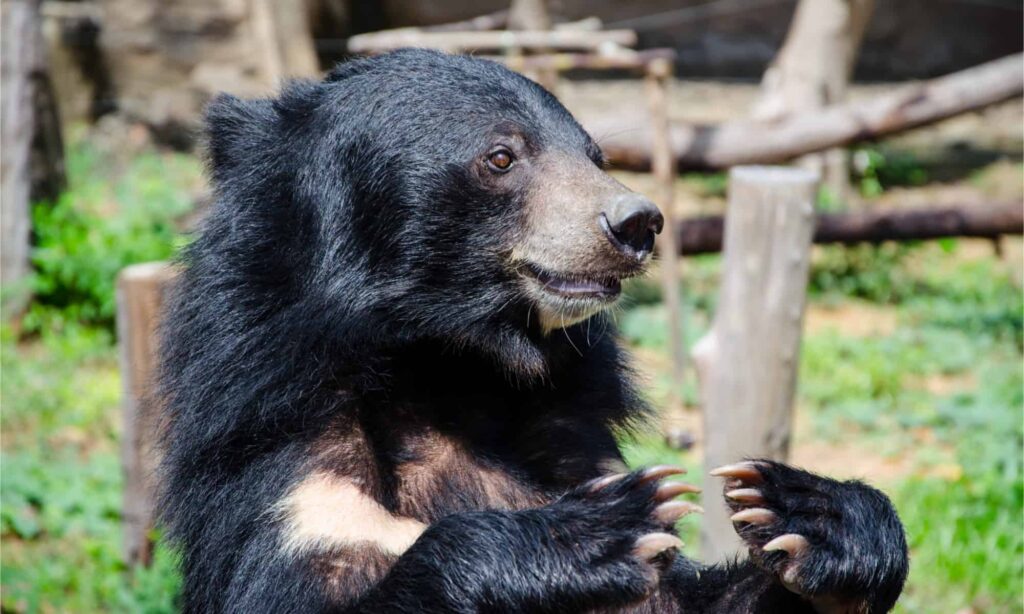Asiatic Black Bear
Ursus tibetanus
Known to eat 160 different tree-borne fruits in Thailand!
Advertisement
Asiatic Black Bear Scientific Classification
- Kingdom
- Animalia
- Phylum
- Chordata
- Class
- Mammalia
- Order
- Carnivora
- Family
- Ursidae
- Genus
- Ursus
- Scientific Name
- Ursus tibetanus
Read our Complete Guide to Classification of Animals.
Asiatic Black Bear Conservation Status
Asiatic Black Bear Facts
- Prey
- Nuts, Fruits, Insects
- Name Of Young
- Cub
- Group Behavior
- Solitary
- Fun Fact
- Known to eat 160 different tree-borne fruits in Thailand!
- Estimated Population Size
- 50,000
- Biggest Threat
- Hunting and Habitat loss
- Most Distinctive Feature
- Distinctive v-shaped marking on chest
- Other Name(s)
- Asian Black Bear, Himalayan Black Bear, Tibetan Black Bear, Moon Bear
- Gestation Period
- 6 - 8 months
- Habitat
- Deciduous Tropical Forest
- Predators
- Tiger, Wolves, Humans
- Diet
- Omnivore
- Average Litter Size
- 2
- Lifestyle
- Nocturnal
- Common Name
- Asiatic Black Bear
- Number Of Species
- 7
- Location
- Central and Southern Asia, Russia and Japan
- Slogan
- Known to eat 160 different tree-borne fruits in Thailand!
- Group
- Mammal
Asiatic Black Bear Physical Characteristics
- Color
- Brown
- Black
- White
- Skin Type
- Fur
- Top Speed
- 25 mph
- Lifespan
- 15 - 25 years
- Weight
- 90kg - 200kg (198lbs - 440lbs)
- Height
- 1.2m - 1.9m (4ft - 6.25ft)
- Age of Sexual Maturity
- 4 - 5 years
- Age of Weaning
- 6 months
View all of the Asiatic Black Bear images!

Asiatic Black Bear Classification and Evolution
The Asiatic Black Bear is a medium to large-sized species of bear that is found inhabiting the deciduous tropical forest throughout Asia. Known to be closely related to the American Black Bear, the two species exhibit a number of similarities including their size, appearance, and behavior, and are thought to have actually shared a common ancestor some 4 million years ago.
Unlike the American Black Bear, however, which is showing increases in population numbers, particularly in certain areas, the Asiatic Black Bear is considered to be an endangered species throughout its native range today as populations have declined drastically due to both loss of their natural habitats to deforestation and the fact they are the most prized of all bear species that are hunted for their body parts (mainly the gall bladder) that are used in traditional medicines and also as a culinary delicacy in some areas.
Anatomy and Appearance

©SamiPu/Shutterstock.com
Like the other seven bear species found around the world, the Asiatic Black Bear has a strong and sturdy body with a large head and thick-set legs which are strong enough to enable the Asiatic Black Bear to both stands and walk on, using bipedal movement in order to make themselves appear even bigger when they feel threatened or are competing for territory with other individuals.
Asiatic Black Bears have a black coat of fur (sometimes brown or even blonde depending on the subspecies) with a distinctive whitish v-shaped marking on their chest and a ruff of longer fur around their necks which again is thought to help to make them appear larger in size than they actually are.
As with other bear species, Asiatic Black Bears have a keen sense of smell that is vital in helping them to find food and is reflected in their impressively long snout.
However, despite the fact that their ears are larger than those of their relatives, they share the same bad sight and hearing and so rely heavily on their sense of smell to figure out their surroundings.
Distribution and Habitat

Asiatic Black Bear is found throughout Europe and Asia
©Guérin Nicolas (messages), CC BY-SA 3.0, via Wikimedia Commons – License
Asiatic Black Bears would have once been found throughout both Europe and Asia with fossil records having been uncovered from as far west as France and Germany, but have more recently been confined to regions in Central and Southern Asia from Afghanistan to Japan and south to Thailand with a handful of populations also found as far north as Russia.
Although they have a relatively wide distribution throughout South-East Asia as well including Myanmar, Vietnam, Laos, Cambodia, and Thailand they are today absent from Malaysia, possibly due to the overlap of these territories with that of the Sun Bear. Their exact habitats depend on the geographical region where they are found although Asiatic Black Bears prefer deciduous forests and brushland at lower altitudes.
Despite this though, the encroachment of human activity on these lowland regions from increasing levels of agriculture and growing human settlements has resulted in the remaining populations of Asiatic Black Bears being pushed into small and isolated pockets of vegetation at higher altitudes.
Behavior and Lifestyle

Black bears will usually run away from dogs and are solitary animals
©Volodymyr Burdiak/Shutterstock.com
As with other bear species (and indeed many large carnivores), Asiatic Black Bears are solitary animals that only come together to mate or when competing for more desirable territories. Despite their relatively small claws, Asiatic Black Bears are highly efficient climbers and spend most of their time foraging high in the trees where they inadvertently build nests from the folding of branches caused by them reaching for fruits and hunting small animals.
In colder climates in the more northern regions of the natural range, Asiatic Black Bears also hibernate through the winter months and so spend the autumn months consuming foods such as acorns, beechnuts, and walnuts that have a high-fat content in order to build up a good layer of fat to keep them sustained throughout the winter.
Although they tend to hibernate from November right through until April, in parts of Russia, particularly where the weather is more hostile than further south, some populations are known to enter their winter dens as early as October and do not emerge until late May.
Reproduction and Life Cycles

Young Himalayan bear cub in a summer forest
©Alexander Khitrov/Shutterstock.com
Asiatic Black Bears are able to breed when they are between 4 and 5 years old and do so during the warmer summer months of June and July. After a gestation period that lasts from between 6 to 8 months, 1 to 4 cubs (although usually 2) are born between March and April in the safety and warmth of the female Asiatic Black Bear’s winter den.
Depending on the region, these dens can be found in river beds or in rocky outcrops with even those individuals that do not hibernate in the warmer, southern regions, seeking out the shelter of a den in which to give birth to their young cubs. Asiatic Black Bear cubs are born hairless and rely heavily on the warmth of their mother and her winter home to keep them both safe and warm.
Asiatic Black Bear cubs are weaned when they are six months old and so begin to only eat solid foods rather than relying on the nutrition from their mother’s milk, but often remain with her until they are three years of age. Although Asiatic Black Bears often live to be 30 years old or more in captivity, they rarely exceed the age of 25 in the wild.
Diet and Prey
Despite being classed as carnivores, like other bear species Asiatic Black Bears have a widely varied omnivorous diet meaning that they eat both small animals and plants throughout their natural range. Due to the fact that the fruits, plants, and seeds that they consume do not contain as much nutrition as larger animals would, Asiatic Black Bears spend vast portions of their waking hours foraging in the trees for food.
Acorns, beechnuts, walnuts, and other nuts and seeds, along with fruits such as cherries, bamboo shoots, and leaves, grasses, herbs, grubs, and insects including termites and ants make up the majority of their diet, supplemented by the occasional bird or rodent when other foods are in short supply. Due to the fact that Asiatic Black Bears eat such little meat, their large molar teeth are flat for grinding up vegetation more easily.
In areas where human settlements have encroached heavily on the Asiatic Black Bear’s natural habitats, they are sometimes known to raid agricultural plantations along with taking occasional livestock from farms.
Predators and Threats

Tigers are one of the few natural predators of the Asiatic Black Bear
©Thorsten Spoerlein/Shutterstock.com
The large size and ferocious nature of the Asiatic Black Bear have ensured that they have very few (if any) natural predators throughout their historically vast natural range. Tigers are the main predators of Asiatic Black Bears throughout Asia with the small cubs being particularly vulnerable to predation despite the fierce-some protection provided by the mother.
Asiatic Black Bears are also more vulnerable in areas where their natural range overlaps those of other bears including Brown Bears in Russia and they are also threatened by packs of Wolves in some parts of their natural range.
People, however, have been and still remain, the biggest threat to the world’s Asiatic Black Bear population as they are severely affected by the loss of their natural habitats to deforestation to either clear land for agriculture or increase the size of growing human settlements.
They are also severely threatened by the hunting of them for their body parts that are highly prized in traditional medicines and despite the ban of their hunting in all countries with the exception of Japan, the trade still continues throughout their natural range today.
Interesting Facts and Features

Asiatic black bear is also known as the moon bear and the Asian Black Bear
©TB studio/Shutterstock.com
The Asiatic Black Bear is known by a number of other names in Asia including both the Asian Black Bear, the Himalayan Black Bear, and the Tibetan Black Bear which is where their scientific name originates from. The whitish v-shaped marking on their chest has also led to them being known as the “Moon Bear” in many regions and led to them being thought to have been most closely related to Sloth Bears and Sun Bears until very recently.
Unlike the majority of other bear species. Asiatic Black Bears are largely nocturnal animals that spend most of the daytime hours sleeping in nests or hollow trees or caves during the day, only coming out under the cover of night to forage for food.
Asiatic Black Bears are known to feed on a wide variety of small animals and plant matter throughout their natural range with their exact diet being heavily dependent on their location on the time of year.
A recent study conducted in Thailand however has revealed that Asiatic Black Bears there are known to feed on 160 species of tree-borne fruits alone.
Relationship with Humans

Asiatic Black Bears disappearing completely from certain areas due to humans
©Jeff Egnaczyk (post406) / CC BY 2.0, Flickr – License
For 3,000 years people have hunted Asiatic Black Bears mainly for their paws and gallbladders as dried bile is used in traditional Chinese medicines and is believed to contain numerous healing properties.
This has led to them being captured and kept in bile farms, particularly in China and Vietnam where their living conditions are often a great cause for concern for environmental activists and conservationists.
This industry alone has contributed heavily to the severe decline in population numbers and coupled more recently with habitat loss could see Asiatic Black Bears disappearing completely from certain areas. Although cases are rare, they have been known to cause human fatalities in areas where settlements encroach heavily on their dwindling natural habitats and so many are often hunted as pests or threats, despite the killing of them is illegal.
Asiatic Black Bears are often captured and kept as pets and captured in Pakistan to fight dogs, in a process known as bear baiting. Not only is this sport morally horrendously wrong but the teeth and claws of the Asiatic Black Bears are also removed before the fighting begins so they have no chance to defend themselves against the onslaught of the Bull Terriers.
Conservation Status and Life Today
Today, Asiatic Black Bears are listed by the IUCN’s Red List as a species that is Endangered in its natural environment and could become extinct in the near future if the situation continues without change. It is thought that populations could have declined by as much as 49% over the past 30 years alone and although no official estimates have been produced, it is widely believed that there are fewer than 50,000 left in the wild today.
Despite the ban on their hunting throughout their natural range with the exception of Japan where numbers are thought to actually be increasing, Asiatic Black Bears remain heavily threatened by both hunting and habitat loss, along with the capture of them as pets, for sport or to spend the rest of their days in the misery of a bile farm.
View all 194 animals that start with AAsiatic Black Bear FAQs (Frequently Asked Questions)
Are Asiatic Black Bears herbivores, carnivores, or omnivores?
Asiatic Black Bears are Omnivores, meaning they eat both plants and other animals.
What Kingdom do Asiatic Black Bears belong to?
Asiatic Black Bears belong to the Kingdom Animalia.
What class do Asiatic Black Bears belong to?
Asiatic Black Bears belong to the class Mammalia.
What phylum to Asiatic Black Bears belong to?
Asiatic Black Bears belong to the phylum Chordata.
What family do Asiatic Black Bears belong to?
Asiatic Black Bears belong to the family Ursidae.
What order do Asiatic Black Bears belong to?
Asiatic Black Bears belong to the order Carnivora.
What type of covering do Asiatic Black Bears have?
Asiatic Black Bears are covered in Fur.
What genus do Asiatic Black Bears belong to?
Asiatic Black Bears belong to the genus Ursus.
Where do Asiatic Black Bears live?
Asiatic Black Bears live in central and southern Asia, Russia, and Japan.
In what type of habitat do Asiatic Black Bears live?
Asiatic Black Bears live in deciduous tropical forests.
What are some predators of Asiatic Black Bears?
Predators of Asiatic Black Bears include tigers, wolves, and humans.
How many babies do Asiatic Black Bears have?
The average number of babies an Asiatic Black Bear has is 2.
What is an interesting fact about Asiatic Black Bears?
Asiatic Black Bears are known to eat 160 different tree-borne fruits in Thailand!
What is the scientific name for the Asiatic Black Bear?
The scientific name for the Asiatic Black Bear is Ursus tibetanus.
What is the lifespan of an Asiatic Black Bear?
Asiatic Black Bears can live for 15 to 25 years.
What is a baby Asiatic Black Bear called?
A baby Asiatic Black Bear is called a cub.
How many species of Asiatic Black Bear are there?
There are 7 species of Asiatic Black Bear.
What is the biggest threat to the Asiatic Black Bear?
The biggest threats to the Asiatic Black Bear are hunting and habitat loss.
What is another name for the Asiatic Black Bear?
The Asiatic Black Bear is also called the Asian black bear, Himalayan black bear, Tibetan black bear, or moon bear.
How many Asiatic Black Bears are left in the world?
There are 50,000 Asiatic Black Bears left in the world.
How fast is an Asiatic Black Bear?
An Asiatic Black Bear can travel at speeds of up to 25 miles per hour.
What are the differences between sun bear and moon bear?
The greatest differences between a moon bear and a sun bear are their morphology and behavior. Moon bears are solitary creatures that are aggressive towards humans and hibernate in colder climates, possess longer black fur than a sun bear as well as a V-shaped marking on their chest, and have large bell-shaped ears along with a light brown muzzle. Sun bears do not hibernate and rarely have fatal encounters with humans, possess short black fur, small ears, a short snout, and a U-shaped or semi-circle patch of white or orange fur on their chests.
How to say Asiatic Black Bear in ...
Thank you for reading! Have some feedback for us? Contact the AZ Animals editorial team.
Sources
- David Burnie, Dorling Kindersley (2011) Animal, The Definitive Visual Guide To The World's Wildlife
- Tom Jackson, Lorenz Books (2007) The World Encyclopedia Of Animals
- David Burnie, Kingfisher (2011) The Kingfisher Animal Encyclopedia
- Richard Mackay, University of California Press (2009) The Atlas Of Endangered Species
- David Burnie, Dorling Kindersley (2008) Illustrated Encyclopedia Of Animals
- Dorling Kindersley (2006) Dorling Kindersley Encyclopedia Of Animals
- David W. Macdonald, Oxford University Press (2010) The Encyclopedia Of Mammals
- Asiatic Black Bear Information, Available here: http://www.iucnredlist.org/details/22824/0

















